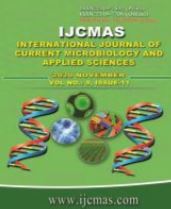


 National Academy of Agricultural Sciences (NAAS)
National Academy of Agricultural Sciences (NAAS)

|
PRINT ISSN : 2319-7692
Online ISSN : 2319-7706 Issues : 12 per year Publisher : Excellent Publishers Email : editorijcmas@gmail.com / submit@ijcmas.com Editor-in-chief: Dr.M.Prakash Index Copernicus ICV 2018: 95.39 NAAS RATING 2020: 5.38 |
The empowerment of women has been apparent as a central issue in deciding their status in recent years. Self-help group is more than a decade old concept and can be effectively viewed as one of tools to enhance rural economic development. In 1976, Md. Yunus who began the Grameen Bank and for which he won the Noble Peace Prize practiced the idea of a self-help group in Bangladesh as a means to provide monetary assistance to the poor rural population. He is viewed as the “Father of Microfinance Industry.” The Grameen Bank offered the least fortunate of the poor micro credits or Grameen credit without any collateral. Witnessing the success of the self-help group in Bangladesh, the concept was presented in India by a non-government organization (NGO) known as Mysore Resettlement and Development Agency (MYRADA) in 1987-88. In 1987, the National Bank for Agriculture and Rural Development (NABARD) gave an asset of 1 million rupees to MYRADA in order to promote the functioning of SHGs. Later in 1989 NABARD again distributed funds to other NGOs for the SHGs. In 1990, the Reserve Bank of India (RBI) recognized SHG as a mode of rural microfinance. A significant advancement came when NABARD led to the rules and guidelines that would allow SHGs to directly lend from banks. In 1992, the SHG bank linkage program was started. Further, in 1993 SHGs were allowed to open its own saving bank account by the RBI. The State Bank of India began providing financial support to SHGs in 1996-97 and from that point forward continued providing assistance to the SHGs. As per to McKinsey Global Report, if all nations were to match the momentum toward gender parity of the fastest-improving countries in their region, $ 12 trillion a year could be added in 2025, boosting the country’s annual GDP growth by 1.4 percentages. Empowering women is the answer for many societal and economic crises on a global level beginning from poverty. Societies that work to up lift women depict better indicators of growth are steady, coordinated, organized, and less vulnerable to Violence.
 |
 |
 |
 |
 |